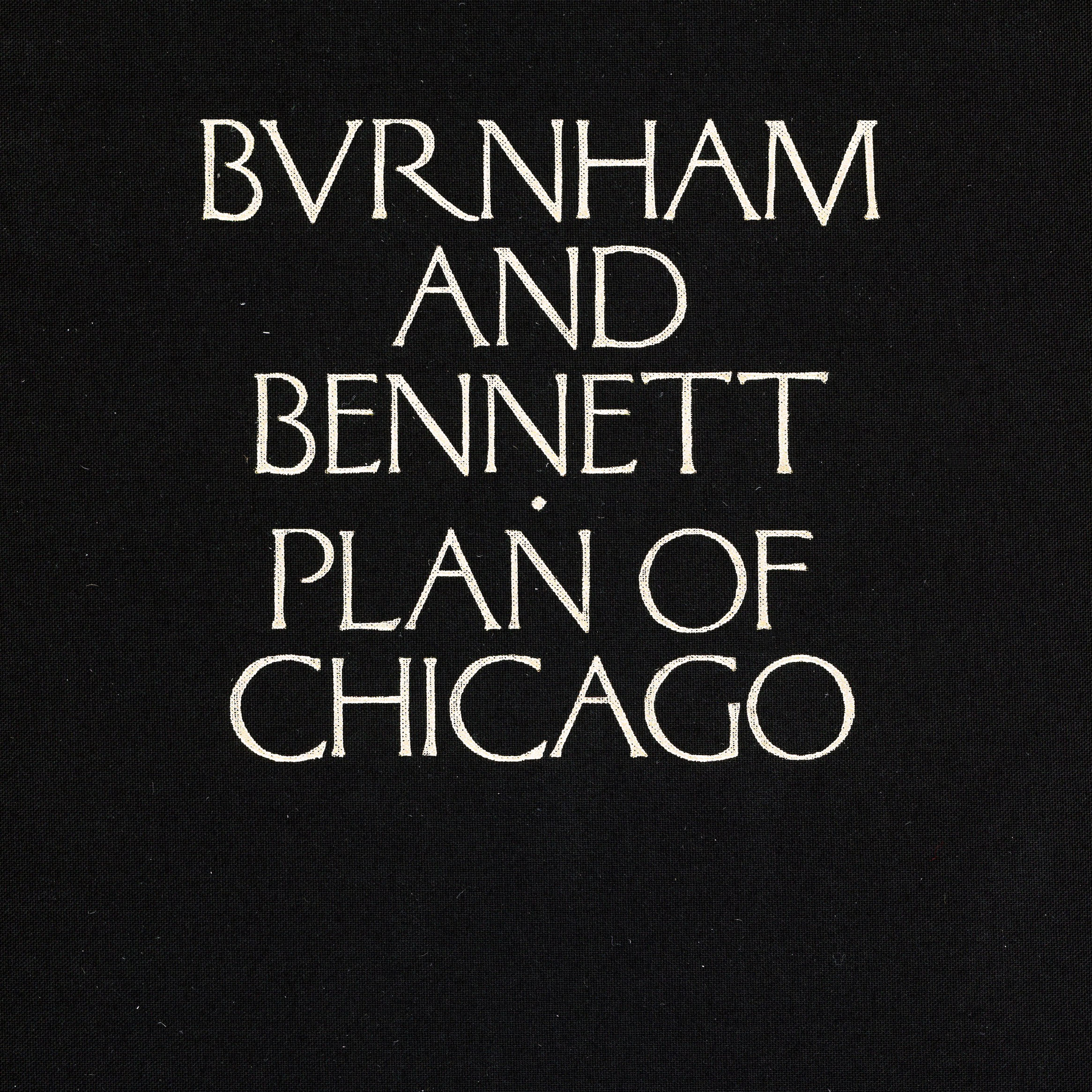* * *
Title: The Plan of Chicago
Author: Daniel H. Burnham, Edward H. Bennett
Publisher: Princeton Architectural Press. 1909 (reprinted in 1996). ISBN: 9781878271419
Language: English
268 pages
***
Chicago in the collective imaginary: Chicago, the city of the skyscrapers. Chicago, the city of the wind. Chicago, the city of the snowstorm. Chicago and the Michigan lake. Chicago and The Loop. Chicago and its holistic urbanism: American, vertical, rational, interconnected.
Chicago en el imaginario colectivo: Chicago, ciudad de los rascacielos. Chicago, ciudad de los vientos. Chicago ciudad de las tormentas de nieve. Chicago y el lago Michigan. Chicago y el Loop. Chicago y su urbanismo holístico: norteamericano, vertical, racional, interconectado.
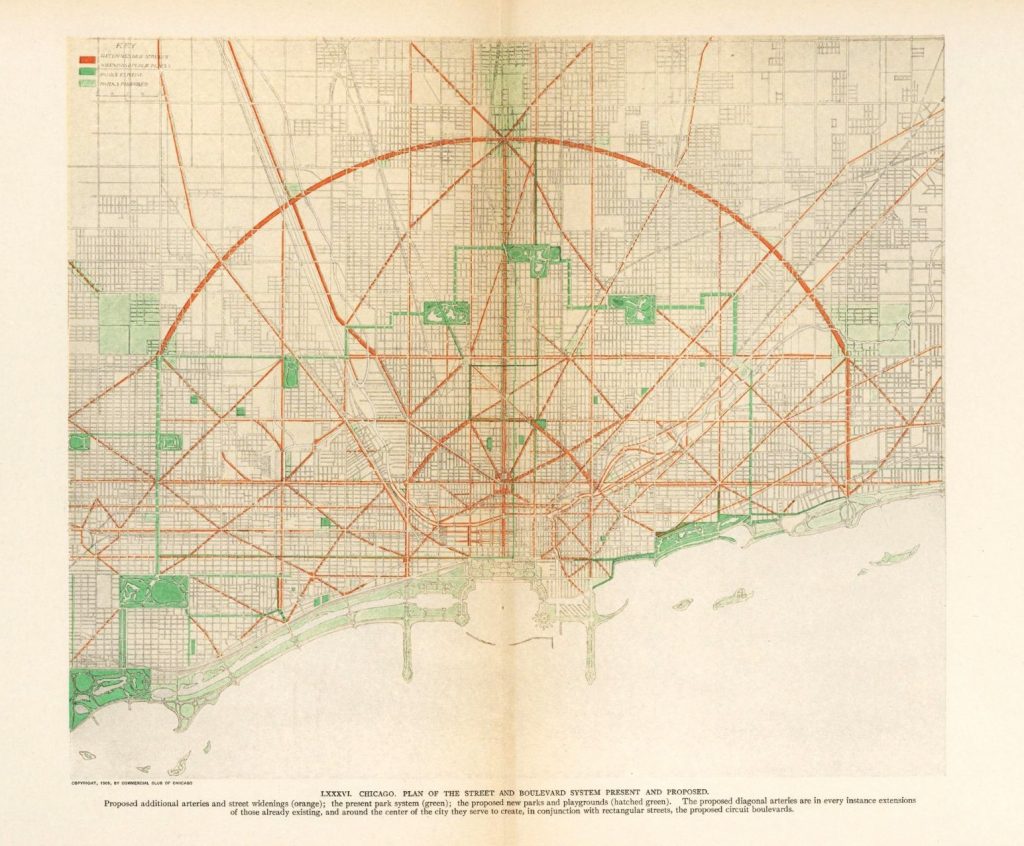
Burnham, Daniel H., and Edward H. Bennett, Plan of Chicago, the Commercial Club, Chicago MCMIX [1909]. Image via Chicago Architecture Center
I started to read the book The Plan of Chicago, which was written in 1909 by Daniel Burnham and Edward H. Bennet as part of a new Urban Project, after a short visit to Chicago. The book was re-edited by Princeton Architectural Press in 1996 within the series Classic Reprint. I already knew the connection between the urban plan and its materialization could be intriguing and disappointing. The maximalist positions of the author of the project stumbled into the built environment. At the same time, it was surprising and comforting other situations that the urban designer could not imagine or control. They enriched the original urban model. Chicago is a city with a remarkable urban space where urbanism, architecture, and cultural model work together. The city fluctuates between these two situations: an urban plan that was not fully implemented and a new town that was born within it.
Tras visitar Chicago recientemente, me sumerjo en la lectura del libro The Plan of Chicago, escrito Daniel Burnham y Edward H. Bennett en 1909 como parte de un nuevo proyecto urbanístico, y reeditado por Princeton Architectural Press en 1996 dentro de la serie de Classic Reprint. Sabiendo que el vínculo entre un plan urbano y su materialización a lo largo de un siglo siempre nos va a encaminar a un lugar entre la inquietud y la decepción; que la realidad construida y su propia evolución colisionan con las posiciones maximalistas del autor del plan. Al mismo tiempo, uno se sorprende y reconforta con otras situaciones que no pueden ser imaginadas y controladas por el urbanista pero que enriquecen el modelo urbano propuesto. Chicago, una ciudad con una calidad urbana magnífica, donde urbanismo, arquitectura y modelo cultural se alimentan entre sí. Y Chicago es una ciudad que se mueve entre estas dos realidades.
But, how can we analyze nowadays an urban plan that was written in 1909? A historical document that is framed in a physical and historical period?
Pero ¿cómo se analiza en la actualidad un plan urbano de 1909?, ¿un documento histórico enmarcado en un periodo temporal y físico muy específico?
Visiting the city of Chicago first and reading the Burnham plan after is a fascinating exercise to understand the transformation of a town from the text, to the graphic illustration, and, finally, to its construction. Instead of making a critical analysis of a plan that was published one hundred years ago, we believe more appropriate to face a transversal approach through four different aspects, from the own narrative of the text to the current edition of Princeton Architectural Press.
Visitar la ciudad de Chicago y leer el plan de Burnham posteriormente, es un ejercicio muy interesante para entender la transformación desde el texto o la normativa, al dibujo y luego a la materialización física. En lugar de realizar una crítica al propio plan, poco apropiado ya que fue publicado por primera vez hace más de cien años, mi objetivo es un análisis transversal a través de cuatro aspectos, desde la propia narrativa de Burnham y Bennet hasta la edición actual de Princeton Architectural Press.

Burnham, Daniel H., and Edward H. Bennett, Plan of Chicago, the Commercial Club, Chicago MCMIX [1909]. Image via Chicago Architecture Center
Physical and Historical Context | Contexto Histórico y Físico
The starting point of Burnham was the optimism that occurred after the Colombian World exhibition of Chicago – that he designed himself in 1983 – and the growth of the city between the XIX and the XX centuries. His urban model was European. He used references of the urban plans of Paris, Vienna, and London as well as the city of Washington that had previously followed a similar approach. During the first chapters of The Plan of Chicago – Origins of the Plan of Chicago and City Planning in Ancient and Modern Times – Burnham defines the different priorities of the city. He also describes the design parameters such as order and symmetry, the creation o fan interconnected system of Parks, and a hygienic city.
Los puntos de partida de Burnham fueron el espíritu de prosperidad surgido tras la Exposición Mundial Colombina de Chicago, proyectada por el mismo en 1893, y la gran expansión de la ciudad durante el cambio de siglo. Su modelo propuesto fue claramente eurocéntrico tomando como referencias los planes urbanos de Paris, Viena y Londres, así como la ciudad estadounidense de Washington, que ya se había utilizado un tipo de urbanismo similar. En los primeros capítulos del Plan de Chicago – Origins of the Plan of Chicago and City Planning in Ancient and Modern Times – Burnham establece los parámetros para tener en cuenta y describe las prioridades urbanas tales como orden y simetría, sistema de parques interconectados o ciudad higiénica.
Moreover, Burnham’s approach to the physical context appears in Chapter III – Chicago, the metropolis of the Middle West. He explains the geographical and political position of the city: the relation with the lake, the importance of the town within the political landscape of the mid-west, etc. This chapter describes as well the possibilities of expansion, and the relationship between the American capitalist model at the beginning of the XX century and the growth of the city.
Asimismo, Burnham se aproxima al contexto físico en el capítulo III – Chicago, the metropolis of the Middle West – donde explica la posición geográfica y política de la ciudad (la relación con el lago, la importancia de la ciudad dentro del paisaje político del medio oeste, etc.), sus posibilidades de expansión y la relación entre el modelo capitalista estadounidense a principio del siglo XX y las posibilidades de crecimiento de la ciudad.
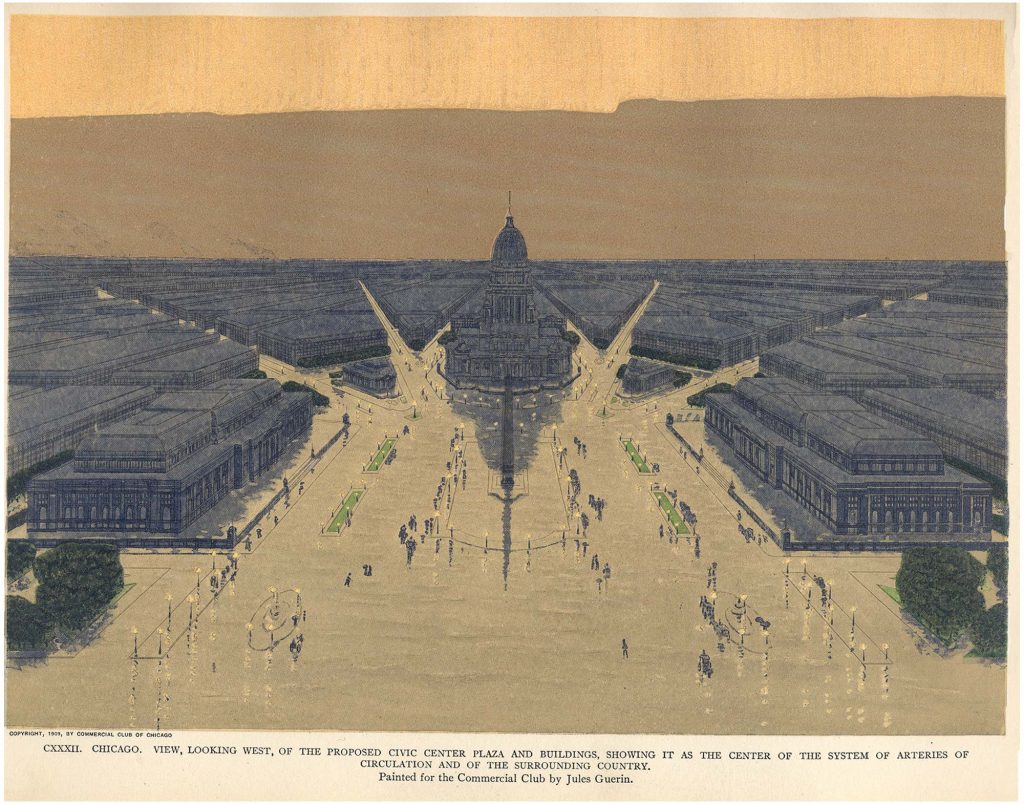
Burnham, Daniel H., and Edward H. Bennett, Plan of Chicago, the Commercial Club, Chicago MCMIX [1909]. Image via Wikipedia.
Progressive approach | Enfoque Progresista
Beyond the formal or aesthetical values, the Burnham and Bennet proposal stands out for its social approach. The Plan of Chicago attempted to cover all the necessities of the citizens, from its education, to a hygienic public space. It is remarkable the preface from Kristen Schaffer, where he studies the social agenda of the project as well as where he relates some of the most progressive parts of the project.
Más allá de valores formales o estéticos, la propuesta de Burnham y Bennet destaca por tener un alto enfoque social. El Plan de Chicago trata de cubrir las necesidades de sus ciudadanos, desde su educación a la salubridad del espacio público. Es interesante el prefacio de Kristen Schaffer donde analiza la agenda social del proyecto, así como cuando explica que algunas de las partes más progresistas del proyecto fueron modificadas en su versión final.
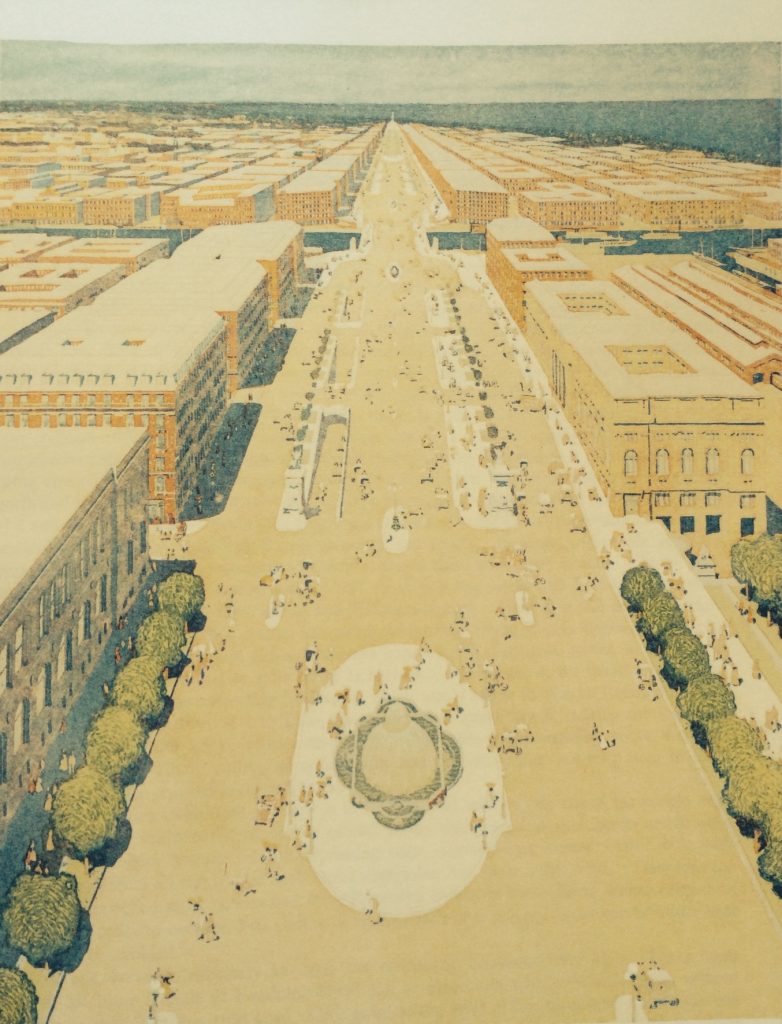
Burnham, Daniel H., and Edward H. Bennett, Plan of Chicago, the Commercial Club, Chicago MCMIX [1909]. Image via Wikipedia Burnham Plan Centennial
Clarity in the Narrative | Claridad en la narrativa
Burnham and Bennet wrote the plan with a clear and pedagogical narrative. The narrative allows us to read it with different levels of information. After the first three chapters where the authors made a contextual, historical, and geographic approach, the text defines the various aspects of the projects such as green areas, transportation, street system, and the heart of the city as its core. The book finishes with a brief chapter where Burnham explains the importance of the plan for the future of Chicago. Through this journey, the reader can easily understand the initial approach of the project, its development, and the final aims.
El Plan de Burnham y Bennet, redactado de un modo claro y pedagógico, permite ser leído con distintos niveles de minuciosidad y complejidad. Tras los tres primeros capítulos donde los autores realizan un análisis contextual, histórico y geográfico, el texto pasa a definir de manera diferenciada los distintos aspectos del proyecto tales como zonas verdes, transporte, sistema de calles propuesto y el corazón de la ciudad como núcleo vertebrador. El libro finaliza con un breve capitulo donde Burnham explica la importancia de propio plan para Chicago en el futuro de la ciudad. A través de este recorrido, uno puede fácilmente entender los planteamientos iniciales del proyecto, su desarrollo y los objetivos últimos de la propuesta.
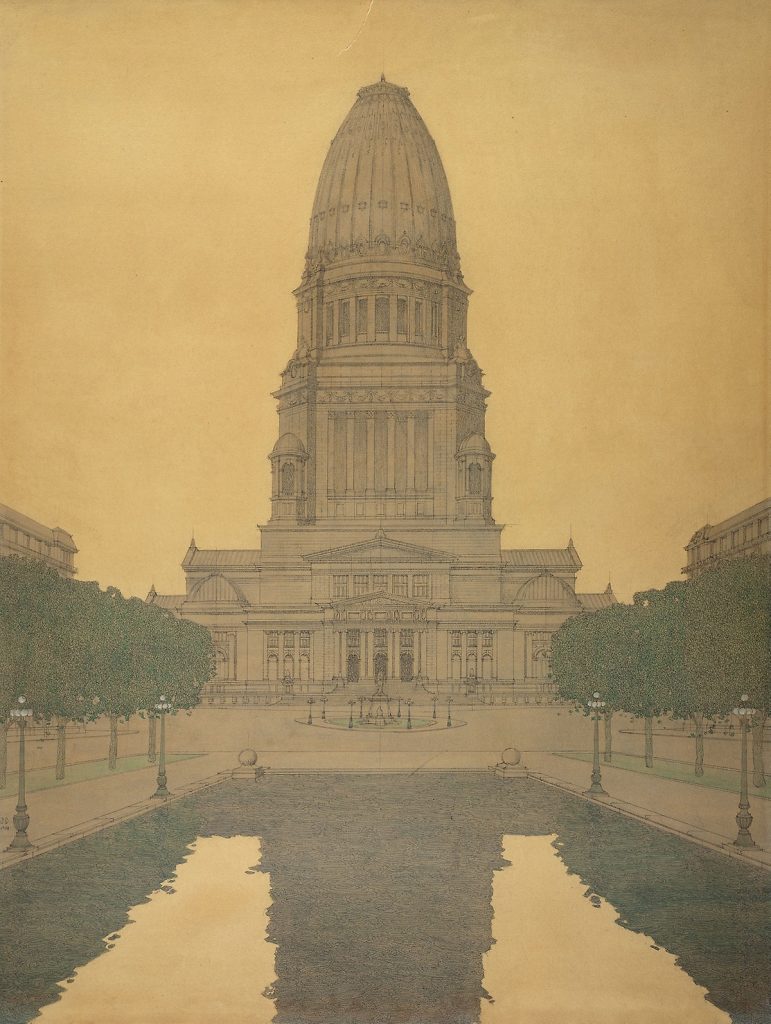
Burnham, Daniel H., and Edward H. Bennett, Plan of Chicago, the Commercial Club, Chicago MCMIX [1909]. Image via Wikipedia
Quality of the publication| Calidad de la publicación
When a reader opens the book for the first time, the first observation is its cared edition. That allows having the first reading through its illustrations. Daniel Burnham commissioned the draftsman Jules Guérin to create a series of blueprints and perspectives that would illustrate his text. Princeton Architectural Press, continuing the elegance of the series Classic Reprints, follows the design of the first edition. Moreover, it has printed some of the drawings in double and triple pages. Then, the readers can also carefully the project through its images.
Cuando uno abre el libro por primera vez, lo primero que observa es el cuidado con el que ha sido editado. Ello permite tener una primera lectura más ligera a través de sus ilustraciones. Daniel Burnham engargó al ilustrador Jules Guérin que realizara una serie de planos y perspectivas que acompañaran su escrito. Princeton Architectural Press, siguiendo la elegancia de la serie de Classic Reprint es fiel a la primera edición del texto, respetando su diseño original. Además, ha dispuesto varios de los dibujos a doble y triple cara, lo que permite que nos podamos deleitar estudiando dichas imágenes.
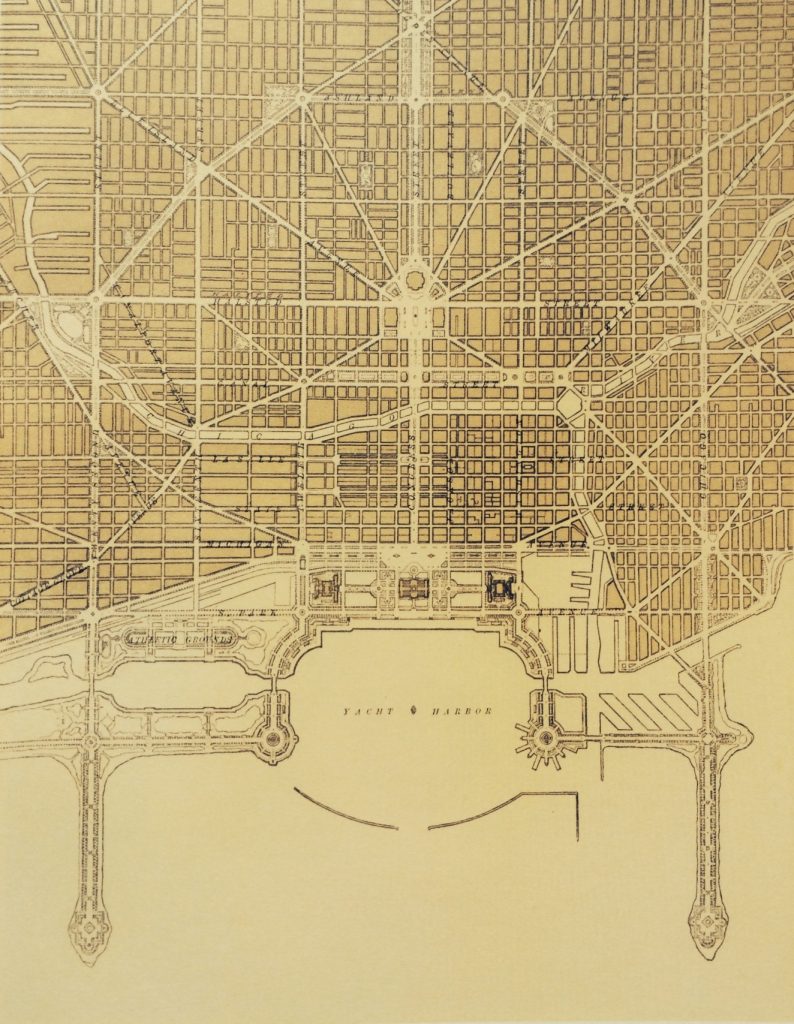
Burnham, Daniel H., and Edward H. Bennett, Plan of Chicago, the Commercial Club, Chicago MCMIX [1909]. Image via buildingchicago.wordpress.com
To summarize, The Plan of Chicago is a text to enjoy progressive urbanism. Its images, full of spatial complexity, enrich writing that has a clear aspiration to transform and improve the lives of its citizens through urbanism. The last reading of this book is to observe the evolution of Chicago in the previous hundred years, from its first publication. Many of the ideas were not developed and built, especially those that were more formal or aesthetical driven. Chicago never ended up being the French city that Burnham imagined: the symmetries, the neoclassical monumentality, and the ample avenues were never built.
En definitiva, The Plan of Chicago es un texto para disfrutar de un urbanismo progresista. Sus imágenes llenas de complejidad espacial acompañan a un texto que tiene una clara aspiración de transformar y mejorar la vida de sus ciudadanos a través del urbanismo. La última lectura del libro es observar la evolución de Chicago en los últimos cien años, desde su primera publicación. Muchas de las ideas no fueron totalmente implementadas, siendo aquellas que afectan a aspectos más formales o estéticos. Chicago nunca ha llegado a ser la ciudad afrancesada que imaginó Burnham: Las simetrías, la monumentalidad neoclásica y las grandes avenidas nunca llegaron a implantarse.
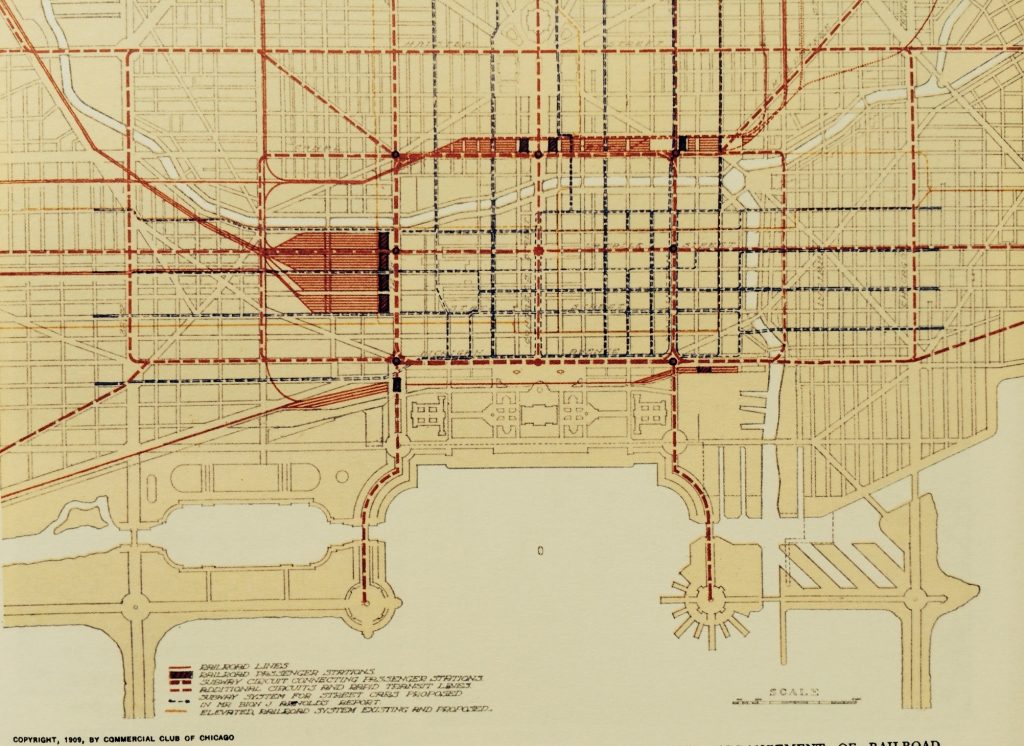
Burnham, Daniel H., and Edward H. Bennett, Plan of Chicago, the Commercial Club, Chicago MCMIX [1909]. Image via buildingchicago.wordpress.com
On the other hand, the construction of skyscrapers, both at the beginning of the XX Century with Louis Sullivan, among others and later, with the corporative architecture of SOM, transformed the initial concept for Chicago into a hybrid urban typology. The city maintained part of the character of the original plan: the pedestrian scale and the idea of a hygienic city opened to the lake through a large linear park. At the same time, the city embraced the verticality of the American downtowns creating a sort of vertical Haussmann plan. Nonetheless, the essential part of this urbanism is to understand that the city has a strong concept behind it. It will help to face the urban challenges of this century. The Plan of Chicago is the book that explains the basis and the structure of this starting point.
Por el contrario, la llegada del rascacielos, tanto a principios del siglo XX con arquitectos como Louis Sullivan o más adelante, de la arquitectura corporativa de SOM, transformaron el concepto inicial en una tipología urbana más híbrida. La ciudad mantuvo parte del carácter del plan inicial, la escala del peatón y una aproximación higienista y abierta al lago a través de un gran parque lineal. Al mismo tiempo acogió con entusiasmo la verticalidad de los downtowns americanos, creando una especie de plan Haussmann extruido en vertical. Más importante aún, es entender que para los retos urbanos de este nuevo siglo, Chicago parte con una idea de clara de ciudad que le permitirá transformarse sabiendo de donde viene. The Plan of Chicago es el libro que permite comprender las bases y el funcionamiento de dicho punto de partida.
